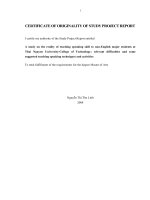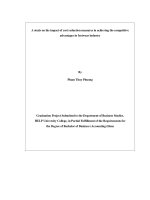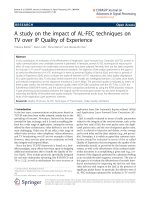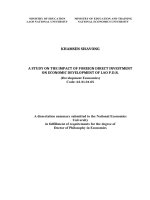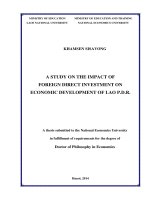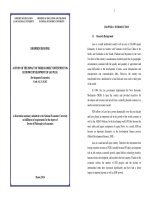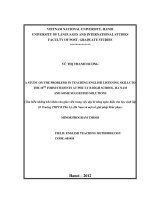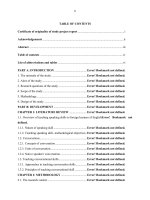A STUDY ON THE IMPACT OF TEACHING INFERENTIAL READING SKILLS TO EFL
Bạn đang xem bản rút gọn của tài liệu. Xem và tải ngay bản đầy đủ của tài liệu tại đây (533.6 KB, 106 trang )
i
MINISTRY OF EDUCATION AND TRAINING
VINH UNIVERSITY
VO NGOC ANH
A STUDY ON THE IMPACT OF TEACHING
INFERENTIAL READING SKILLS TO EFL
HIGH SCHOOL STUDENTS
Major: Teaching English to Speakers of Other Languages (TESOL)
Code: 60140111
MASTER’S THESIS IN EDUCATION
SUPERVISOR: TRAN THI NGOC YEN
VINH, 8/2017
i
ABSTRACT
Inferential reading skill courses have been considered an effective method
to improve learners’ reading comprehension. Research in this area has
concentrated on the categorization of inferences, but an insufficient amount of
investigation has been done into the effect of an inferential reading skill course
on students’ reading comprehension development. This thesis, in the first place,
seeks to determine if teaching inferential reading skills to English as a Foreign
Language (EFL) learners helps them to improve their reading comprehension.
The study, in the second place, aims to determine if learning inferential reading
skills will motivate EFL learners to read. In the experiment, an inferential
reading skill course was delivered to a treatment group. Pre-test and post-test
were administered before and after the treatment to assess the participants’
reading comprehension. It was found that the treatment group outperformed the
control group in terms of comprehension. The difference was significant
((p<.001). The data also showed that the treatment group were more motivated
to read than the control group.
ii
ACKNOWLEDGEMENTS
I would like to express my deep gratitude to my distinguished supervisor,
Dr. Tran Thi Ngoc Yen, who I believe is the most caring supervisor, for her
priceless direction, keen insight, precious orientation, warm encouragement, and
continuous support throughout this research. Her dedication and positive
attitudes were sparkling in such a way that it helped to make my research the
final product.
I also wish to thank other distinguished lecturers of the Department of
Foreign Languages, Vinh University, for instructing me during my entire MA
course. Without that, it would have been harder for me to finish this research.
Their dedicated lessons and lectures contributed a significant part in the thesis.
I am in debt to the library center of Vinh University for letting me borrow
useful materials as a precious resource to support my reference source for this
thesis.
I am grateful to Vo Thi Tieu My and Luu Hoang Nhan, teachers at Cho
Gao High School (CGHS), for letting me work with their classes while I was
gathering the data for the research and especially those group members of my eLearning for English teachers and students in Tien Giang Province social
networking page who are enthusiastically in favor of me while carrying out this
statistical processing, for helping me out with technical issues.
I would also like to thank the administrators, teachers, and students at
CGHS, Tien Giang Province for their cooperation and help.
I wish to express my deep appreciation to Department of Education and
Training, Tien Giang Province, for facilitating me in agendas, without which I
would not have been able to sustain the completion of the course, and for
advocating me as always.
Finally, I would like to dedicate this work to my parents-in-law and
family, who have been always supporting me with love and sympathy.
iii
TABLE OF CONTENTS
iv
LIST OF TABLES
Table 1: Research design of the study..................................................................32
Table 2.1: The results of the general test taken by the treatment group and the
control group..........................................................................................................37
Table 2.2: The results of the pre-treatment test taken by the treatment group and
the control group....................................................................................................39
Table 2.3: The students’ performance in the pre- test.........................................40
Table 2.4: The results of the post-treatment test taken by the treatment group and
the control group....................................................................................................41
Table 2.5: The students’ performance in the post- test.......................................43
Table 3: The difference in progress of reading comprehension scores between the
two groups..............................................................................................................44
Initially, there is difference in progress of reading comprehension scores between
the two groups. As can be seen from the statistical table, the value p of t-test is
0.0000 < 0.05 and proves that the difference between the average scores of the
pre-treatment test and the post-treatment test signifies considerably. Accordingly,
the average score of the post-treatment test surpassses the one of the pretreatment test thanks to the treatment effect.......................................................44
Table 4: The results of the opinions on the students‘ attitudes towards the
inferential reading skills instruction by means of the questionnaire.................48
Table 5: The responses to three open-ended questions about teaching inferential
reading skills to the students.................................................................................49
v
LIST OF CHARTS
Chart 1a and chart 1b: The results of the general test taken by the treatment
group and the control group.................................................................................38
Charts 3a nd 3b: The results of the post-treatment test taken by the treatment
group and the control group.................................................................................42
Chart 4a versus chart 4b: The results of the post-treatment test taken by the
treatment group and the control group................................................................45
Chart 5: The distinctive progress of the treatment group over the control group45
................................................................................................................................. 45
Next come the detailed data on the results of the students’performance in the
post-test after the treatment..................................................................................45
Regarding the pass-fail balance of the two groups, the test-takers of the treatment
group who passed the test accounted for 95% whereas, the control group did
82,5%. As a consequence, the treatment group gained a considerable victory over
the control group in the reading comprehension test..........................................45
Chart 6: The results of the opinions on the students‘ attitudes toward the
inferential reading skills instruction by means of the questionnaire.................49
vi
LIST OF DIAGRAMS
Diagram 1: The relationship between the key variables of this study...............33
Diagram 2: The data collection procedures.........................................................34
1
CHAPTER 1: INTRODUCTION
1.1. Rationale
Currently, I work as a specialist of English for Tien Giang Department of
Education and Training (DOET), which means that I am in charge of the English
teaching and learning of the province. It is a common context that during
English tests EFL students are more hopeless at reading comprehension multiple
choice questions (MCQs) than at other kinds of MCQs such as grammar and
vocabulary ones. Our task is to improve the students’ reading comprehension
skill in order to raise their reading scores in the progress, achievement and
proficiency tests. Among the students’ problems with reading comprehension is
one of inferential reading.
The task of ameliorating the students’ reading comprehension has
constantly been a substantial challenge to teachers. The difficulty in reading
even proves to be greater when it comes to dealing with inferential reading
MCQs. Nevertheless, if special efforts are made, the issue will not be as
complex as it is thought. Hereby in this research, the suggestion is that the
problem be confronted by teaching inferential reading skills to the students.
Inferences are the conclusions we offer based on what one already knows
and judgments we make or facts that the information in the passage rules out
based on given information. With this strategy, EFL students connect their prior
schemata with their comprehension of a reading text. This strategy trains
students to think to make new information reshape their previous knowledge.
Inferential reading is a skill and, as a consequence, can be taught. Once students
have developed inferential reading skills, they learn to relate what is happening
in the text to what they have already known of the world, to give explanations
for ideas that are presented in the text, to offer details for events or their own
explanations of the events, to be aware of the author's view of the world even the
author's biases, to draw conclusions from facts presented in the text, or to
comprehend the tone of discourse participants' words and relationships to one
2
another. Inferential reading can also aid EFL students with unfamiliar or
challenging vocabulary by figuring out 1) antecedents for pronouns, 2) the
meaning of unknown words from contextual meanings, and/or 3) the structural
function of an unknown word.
Making inferences denotes information that is implied or ‘inferred’. This
means that the information is never clearly stated. In fact, readers often have to
understand the writers more than what they say directly. Writers provide hints
that help readers ‘read between the lines’. Using these clues to give readers a
deep-down understanding of their reading is called ‘inferring’. By ‘inferring’,
readers go beyond the surface details to see other meanings that the details
suggest or imply (not directly stated). When the connotations of words are not
stated clearly in the context of the text, they may be implied, suggested, or
hinted at. When meanings are implied, readers may ‘infer’ them.
For example, if the text says that "all the glasses on the table are full", an
inference would be that "there are no empty glasses on the table".
1.2. Aims of study
In an attempt to evaluate the effectiveness of the teaching of inferential
reading skills to EFL students and to provide the students with convincing
evidence for whether mastery of inferential reading skills will work or not, this
research is conducted on the impact of the teaching of inferential reading skills
on the improvement of the students’ reading comprehension and their scores in
reading in the progress, achievement and proficiency tests.
1.3. Research questions
1.3.1 Does, and to what extent if it does, teaching inferential reading skills
enhance EFL high school students’ reading comprehension?
1.3.2 Does teaching inferential reading skills increase EFL high school
students' motivation to read?
3
1.4. Scope of study
The study is expected to be applied to EFL high school students at CGHS
in Tien Giang Province. These students range from age 16 to age 18 and they
belong to the eleventh grade. Besides MOET’s English textbooks in the Englishofficial classes, the students selected study Cambridge English books including
KET, PET and IELTS books in their English-intensified extra classes. These
students will take not only GCSE exams but proficiency tests as well.
1.5. Thesis design
The M.A. thesis is composed of five main chapters:
The Introduction states the rationale, aims of study, research questions,
scope of study, and overview of the study.
The Literature Review discusses the viewpoints that the researchers hold
about inferences, the ways to teach inferential reading skills and how the ways
affect students’ reading comprehension.
The Methodology introduces the methods employed to gather
information. Especially, 80 English-intensified students and 1 teacher of English
at CGHS are also involved in the process to provide significant information for
the study. Later, the statistical data are processed through Microsoft Excel.
The Findings and Discussion publish discoveries, which help reveal the
nature of the issue in question on the impact of teaching inferential reading skills
to EFL high school students. Next come recommendations for the teaching and
learning of inferential reading skills.
The Conclusion consists of a few final words based on the findings of the
study done for this M.A. thesis and a brief evaluation on the methods, the
contributions and the limitations of this study. In addition, a prospect for
researching the issue is shown.
4
CHAPTER 2: LITERATURE REVIEW
Up to now a considerable amount of literature has been published on
reading. The information that can be seen below all serves to make up of what
researchers have already known or written of reading and all related.
2.1. The elements of reading
Armbruster, B., Lehr. F, and Osborn, J. (2001) established that the
elements of reading include phonemic awareness, phonics, vocabulary, fluency,
and comprehension and should be emphasized in children’s reading instruction
throughout their early school years. Fluency is the ability to read a text
accurately and quickly. Fluent readers recognize words automatically.
Comprehension is the reason for reading. If readers can read the words but do
not understand what they are reading, they are not really reading.
Anne Kispal (2008) indicated that understanding the reading process
enables us to understand how each of these elements works to help students
become proficient readers. Students combine the elements of reading to produce
words (from their prior knowledge and background) that may fit in the context
of what they are reading. Students immediately filter the meaning of the material
against their comprehension of the material, searching for a match. Both word
meaning (vocabulary) and content meaning (comprehension) work together as
students read and understand their reading.
2.2. The reading process
Verbal efficiency theory, as proposed by Perfetti (1985), tries to explain
the reading process by focusing on eye fixations at fast rates. He assumed that
each reader has a profile of verbal efficiency. The larger the profile, the more
attentional resources are available for higher level skills, the faster the reader
can read. The large profile makes the attentional resources available for higher
level skills and leads to the fast reader.
5
Schema theory (Anderson & Pearson, 1984; Carrell & Eisterhold, 1983)
explains how people organize their knowledge using schemas or knowledge
structures. Thus, it examines reading as a process for studying rather than typical
reading. In other words, their subjects are people who are deliberately reading a
text to learn something from it or to memorize it.
Whole language theory (Goodman, 1989; Watson, 1989) holds that
reading is a natural process which has a close link with speaking, listening and
writing, thus if one of these language skills develops, the others will be
improved as a result. It advises educators to use a child-centred philosophy to
encourage children to learn. This theory addresses normal reading but mainly
deals with young readers rather than adult readers.
Rauding theory, which was proposed and developed by Carver (1990,
1992a, 1993, 2000), focuses on normal reading by both children and adults. As
this theory is the most relevant to the topic of this thesis, it is worthwhile
providing a description of how it works.
As termed by Carver (1992b, p. 85), there are five basic processes, or
reading gears, scanning, skimming, reading 2, studying, and memorizing. Carver
pointed out that readers shift up to the higher gears or down to the lower gears
when their reading purposes change. For instance, when they do not need to
understand every single sentence of the text, they usually utilize skimming. On
the other hand, when they have to know the information well enough to use it
for later purposes, they may shift down to studying or memorizing. However, in
a typical situation, readers only operate at the third gear, reading 2 or rauding.
Although the term rauding in this theory involves both auding (listening) and
reading, only the second dimension will be discussed in this literature review as
the thesis particularly concerns fluency in reading.
6
According to Carver (1997), in the rauding process, readers make
fixations on almost all of the words in the text and comprehend all, or most of
the complete thoughts presented in the text. If readers understand less than
around 75 percent of presented thoughts, they are said to have been reading, but
not rauding. One of the fundamental factors for this process to occur is that the
reading material must be relatively easy. If the text is at a higher level than the
ability level of the reader, the rauding process is unlikely to happen. The
instructions are also an important factor in that if the readers are asked to study
the text carefully so that they will be able to recall the details later, perhaps they
will not utilize the rauding process. These features account for the relevance of
the rauding theory to this research. In the two experiments, the speed reading
texts were 20 stories written within the participants’ vocabulary level. The speed
reading instructions informed the participants that they did not have to
memorize the text for later tests, and that the comprehension level should be
around 70 percent. The pre-test and post-test instructions asked the participants
to read at the speed that they would normally read.
2.2. The nature of reading fluency
Fluency plays a crucial role in proficient reading as once readers become
automatic in decoding, they can devote their attention to comprehending text
(Hiebert & Fisher, 2005). Thus fluency has a close link with comprehension
(Kuhn & Stahl, 2003; McGlinchey & Hixson, 2004; Oakley, 2005; Pinnell,
1995; Rasinski & Padak, 1996; Silberglitt, Burns, Madyun, & Lail, 2006). If
learners cannot attain fluency, it is likely that they cannot reach the consequent
stages of reading ability (Stahl & Heubach, 2005). Fluency also plays a role in
developing readers’ confidence and motivation in that if readers become more
fluent, they tend to enjoy and spend more time reading, which in turn, helps
7
them to develop additional fluency (Oakley, 2005). Besides, fluency has an
association with L1 rauding as Carver (2000) commented:
“If the term fluency is used to refer to the silent reading of relatively easy
text wherein the words are recognized effortlessly at the typical reading rate of
the individual while the complete thoughts in these sentences are being
comprehended as they are read, then fluency and rauding are synonymous
terms”. (p. 5)
Fluency implies more than what is mentioned in the quote because the
research involves learners of English in a foreign language environment. Many
of them may not be able to recognize English words effortlessly while
comprehending most of the sentences being read. However, it can be said that
this kind of fluency is the optimal goal of the language program at the university
and of the treatment. Only when the participants reach the level at which they
can decode words effortlessly and understand most of the thoughts presented in
a text can they be said to achieve rauding. For this reason, a broader review of
the literature on fluency development is necessary.
Most definitions of fluency were proposed in research on L1 reading.
Studies in L2 reading commonly took the theories of L1 reading fluency as the
underpinning. In L1 oral reading, fluency has been defined as reading aloud fast
and accurately (Good & Kaminski, 2002; Oakley, 2005; Welsch, 2006) or
reading aloud with accuracy, and appropriate expression (Armbruster, Lehr, &
Osborn, 2001; Chard, Pikulski, & McDonough, 2005; Huey, 1968; Meyer &
Felton, 1999; Rasinski, 1989; Schreiber, 1987). Appropriate expression includes
such aspects as speed, phrasing, and smoothness.
Although appropriate expression, to some extent, can show the reader’s
understanding of the text (Allerson & Grabe, 1986; Pinnell, 1995; Rasinski,
2003b), fluency is integral to comprehension and the definition of fluency
8
should include comprehension (John & Berglund, 2006; Kuhn & Stahl, 2003;
Rasinski, Blachowicz, & Lems, 2006; Stahl & Heubach, 2005).
In L1 silent reading, fluency is commonly understood as the ability to
read and to comprehend accurately at the same time (Rasinski, 2000, 2003b;
Rasinski, et al., 2006; Samuels, 2006). A fluent reader is a person who has
“freedom from word identification problems that might hinder comprehension”
(Harris & Hodges, 1995, p. 85). This is because in order to have good reading
comprehension, a reader has to be able to identify words easily and quickly
(Samuels, 2002). This definition comes from automaticity theory, which holds
that if a subcomponent skill becomes automatic, that means, it can be done
without using many attentional resources, and the other subcomponent skills
will be more likely to work effectively (Baker & Brown, 1984; Pressley &
Afflerbach, 1995; Walczyk, 2000). Researchers also emphasize the role of
smoothness and appropriate reading rate in reading fluency (Nation, 2005;
Oakley, 2005).
In second and foreign language learning, fluency is defined as “the ability
to speak or write a particular foreign language easily and accurately” (Pearsall,
1998, p. 707) or “making the most effective use of what skills are already
known” (Nation, 1997, p. 30). In particular, reading fluency has received
relatively scant attention. However, a few researchers have consistently regarded
foreign reading fluency as the ability to read and comprehend a text in the
foreign language at an adequate speed and two observable signals of this aspect
are speed and accuracy in comprehension (Gorsuch & Taguchi, 2008; Nation,
2005; Segalowitz, Segalowitz, & Wood, 1998; Yamashita & Ichikawa, 2010).
9
2.3. The indicators of reading fluency
Although
researchers
approach
reading
fluency
from
different
perspectives, a consensus on the indicators of reading fluency has been
established. There is popular agreement that automaticity, accuracy, and reading
speed (for silent reading) or prosody (for oral reading) are the three fundamental
indicators (Grabe, 2004b; Harris & Hodges, 1995; Kuhn & Stahl, 2003;
Rasinski, et al., 2006; Richards, 2000; Tompkins, 2003; Worthy & Broaddus,
2001-2002).
Automaticity is widely accepted as one of the indicators of fluency in
reading. Automaticity is, in general, a term used to define the ability to complete
a task without a large amount of attentional resources being used. In reading,
automaticity is understood as the effortless, accurate and fast recognition of
words in texts. Studies in L1 reading have shown that automaticity is a crucial
component of skilled reading as it allows the reader to save cognitive resources
for more complicated tasks (Schwanenflugel, et al., 2006) and influences
comprehension (Adams, 1994; Just, Anderson, & Carpenter, 1987; Rayner &
Pollatsek, 1989). In other words, word recognition and comprehension compete
for readers’attention. It is likely that readers will not be able to reserve their
attention for comprehension if they have to spend too much time identifying
words (Samuels, 2002). Therefore reading instructors should help readers to
“shift the blend toward automaticity by eliminating or reducing reliance on some
of the controlled processes” (Segalowitz, et al., 1998, p. 54). The overall
principle of chunking is most human beings can apprehend about “seven
recently learned chunks of similarly classified data” (Gobet, et al., 2001, p. 236).
From the reader’s perspective, the chunking principle requires them to group
words into information units. In other words, they no longer process every word
separately but instead process a certain number of words as one unit of
10
information. This in turn will increase their word recognition skills. Thus
“fluency development involves not just becoming faster, it also involves
changing the size and nature of the basic unit that the reader is working with”
(Nation, 2005, p. 25). Since assessment of the recognition unit in reading is
difficult, this aspect of reading fluency has been usually neglected in previous
studies. In the last two decades, there has been an increasing but still small
amount of literature on automatization in L2 reading (Anderson & Pearson,
1984; Carrell & Eisterhold, 1983; Stanovich, 1992). Past research has found that
among L2 university students, those who were more fluent readers also had
better word recognition automaticity skills (Segalowitz, et al., 1998) and that
there is a strong link between high proficiency levels and automatic word
recognition in L2 (Kroll, Michael, Tokowicz, & Dufour, 2002).
Prosody is an important indicator of fluency in oral reading. Previous
research in L1 oral reading has established a set of language features that
compile prosody. These features include stress or emphasis, pitch variations,
intonation, pace, phrasing, and pausing (Dowhower, 1987; Rasinski, 2003a;
Schreiber, 1987).
While in oral reading children’s comprehension can be, to some extent,
conveyed through prosody, in silent reading, there are no immediately
observable clues of readers‟ understanding of the text. Thus many researchers
suggest including comprehension accuracy as an indicator of fluency in silent
reading (Gorsuch & Taguchi, 2008; Nation, 2005; Segalowitz, et al., 1998;
Yamashita & Ichikawa, 2010). It is believed that reading faster will be
meaningless if the reader comprehends little of the text. A fluent reader should
be able to both read quickly and comprehend the text at the same time.
Therefore, comprehension accuracy should be one of the indicators of fluency in
silent reading. Some researchers have suggested a goal of at least 75%
11
comprehension in L1 reading (Carver, 1981, 1992b) or around 70% accuracy in
L2/FL reading (Millett, Quinn, & Nation, 2007). In oral reading, accuracy is
usually associated with decoding. It refers to “the ability to correctly generate a
phonological representation of each word, either because it is part of the reader’s
sight-word vocabulary or by use of a more effortful decoding strategy such as
sounding out the word” (Penner-Wilger, 2008, p. 1). Accuracy in decoding is
usually measured by counting the number of correct words read per minute.
Silent reading speed, or silent reading rate is also popularly accepted as
one of the indicators of silent reading fluency. It is generally understood as the
rate of word recognition, which is the total number of words per minute a person
can recognize. A considerable amount of literature has been published on this
aspect. The studies on L1 reading investigated what people really do when they
are reading fast, including how many fixations, saccades and regressions they
make during the process, how much they can comprehend the text, how people’s
reading rates change and so forth. Researchers have pointed out that a normal
skilled L1 reader reads at around 250-300 wpm and makes approximately 90
fixations per 100 words (Just, et al., 1987; Nation, 1997) while a normal speed
in L1 oral reading should range from 100 to 200 wpm (Nation, 2005). Among
the large volume of published studies exploring how reading rate changes in L1
reading, the most influential studies were undertaken by Carver, who examined
this topic from various perspectives. In his research on the rate of reading prose,
Carver (1982) claimed that there exists an optimal reading speed called rauding
rate at which readers can maximize their efficiency of comprehension and that
300 wpm is a good speed for college students to achieve the best efficiency.
Although the rauding rate may vary among different people it is normally less
than 400 wpm (Carver, 1985). Some very good readers such as speed readers,
professionals, college students, and people who had exceptionally high scores on
12
tests, tend to read at around 300 to 600 wpm. For individuals, the rauding rate is
approximately constant as long as the measurement is modified for word length
(Carver, 1983). Thus, it is possible that teachers can predict how fast a student
will read a text if they know the difficulty level of the text.
This is surprising because it has been commonly thought that reading
speed is affected by such factors as the purpose of reading, the difficulty of the
text, and the reader’s engagement level (Nell, 1988). However, it is worth noting
that rauding rate in Carver’s theory is not identical to the term reading speed
which is commonly used by many other researchers and teachers. Besides,
Carver’s research examined L1 reading and thus his rauding theory may not
apply in the same way in L2 reading.
Research on reading speed in L2/FL silent reading is a relatively new
area. Researchers have suggested that a reasonable goal for second language
learners who are reading materials with no new words should be around 250
wpm (Nation, 2005) but mention that reading speed in L2/FL is slower than in
L1 (Droop & Verhoeven, 2003; Fraser, 2007; Segalowitz, Poulsen, & Komoda,
1991; Taguchi, Gorsuch, & Sasamoto, 2006). Although recently L2/FL
researchers and educators are focusing on methods to increase L2 and FL
reading rate (Day & Bamford, 1998; Grabe, 1991, 2004a; Silberstein, 1994), the
area of reading speed in L2/FL is still in its infancy.
2.4. Assessing reading fluency development
Various studies have been done about how to design a good reading
program to help learners develop their reading fluency. A large and growing
body
of
literature
has investigated
how
fluency
improves
and
has
recommended activities for fluency development. With respect to L1 oral
reading, researchers have proposed conditions to improve fluency and
recommended techniques and activities that can be used in the classroom or
13
outside class to help develop children’s reading fluency. Among those
suggestions are using high-success texts, altering teachers’ patterns of responses
to reading errors (pause-prompt-praise), modeling fluent reading, encouraging
free, voluntary reading, repeated reading, extended and deliberate practice,
orienting student choice (Allington, 2009; Ehri, 1995; Rasinski, 1989; Stahl,
Heubach, & Cramond, 1996; Stahl & Heubach, 2005; Welsch, 2006). Linguists
and language practitioners have also explored activities to promote fluency in
L2/FL reading. Some of these techniques include repeated reading, paired
reading, the 4/3/2 technique, extensive reading aloud, read and look up, speed
reading courses, easy extensive reading, silent repeated reading and issue logs
(Day & Bamford, 1998; Donnes, 1999; Hill, 1997; Krashen, 1995; Nation, 1997,
2005; Paran, 1996; Perfetti, Van Dyke, & Hart, 2001; Redfield, 1999; Taguchi,
Takayasu-Maass, & Gorsuch, 2004).
Several studies also applied the curriculum-based measurement (Deno,
1985) to assess L1 oral reading fluency. This is a general outcomes measure of a
student’s performance in reading, writing, and spelling. In reading, accuracy is
determined by dividing the number of words read correctly per minute by the
total number of words read and comparing the students’ performance against the
target rate norms. Meanwhile the rate is measured by calculating the total
number
of
words
read
correctly
per
minute
and
comparing
the
students’performance against the target rate norms.
This test allows students and teachers to do an evaluation every week
instead of every month. Another method that has been used for decades to assess
L1 oral reading is informal reading inventories which assume that word
decoding ability is a crucial benchmark to mark a reader’s improvement
(Johnson, Kress, & Pikulski, 1987). Along similar lines, some researchers
developed rubrics or fluency norms to assess fluency and overall reading
14
proficiency (Fuchs, Fuchs, Hamlett, Walz, & Germann, 1993; Good &
Kaminski, 2002; Hasbrouck & Tindal, 1992; Marston & Magnusson, 1985;
Rasinski, 2000; Zutell & Rasinski, 1991).
Many studies on measuring L1 oral reading fluency have neglected
comprehension until Allington (1983) called for the incorporation of
comprehension in fluency assessment. He identified ways to assess
comprehension. One of these methods is retelling the story, which requires
readers to remember anything they can about the story. In this method, some
teachers use idea units to make it easier to compare the original story and the
story recalled by the reader. Recently researchers have shown increased interest
in measuring reading comprehension (Daane, Campbell, Grigg, Goodman, &
Oranje, 2005; Pinnell, et al., 1995). Some of them have used a four-point scale
and the results showed a strong link between fluency and reading
comprehension performance (Pinnell, et al., 1995).
Recent developments in teaching and learning the reading skill have
heightened the need for measuring silent reading fluency. As a result, researchers
have attempted to formulate methods to measure reading rate and
comprehension both for L1 silent reading (Juel & Holmes, 1981; Vacca &
Vacca, 1999) and L2/FL silent reading (Gorsuch & Taguchi, 2008). Regarding
reading speed, which is conventionally measured by the words per minute
calculation, the one-minute reading probe and the entire text method have been
used in both L1 reading research (Harris & Sipay, 1985) and L2/FL reading
research (Iwahori, 2008; Lai, 1993; Taguchi, et al., 2004). Particularly in L2/FL
research, the three-minute probe and the ten-second interval method have been
used (Bell, 2001; Macalister, 2008; Millett, 2005b, 2005d; Millett, et al., 2007;
Nuttall, 1982; Sheu, 2003). With respect to comprehension assessment, the most
popular methods to measure comprehension are true-false questions, multiple
15
choice questions, short answer questions, recall tests and participant self-reports
(Alderson, 1990; Gorsuch & Taguchi, 2008; Iwahori, 2008; Lai, 1993; Paretz &
Shoham, 1990; Taguchi, et al., 2006). Typically, in a speed reading course, the
learners are asked to keep a graph of their speed in words read per minute and a
graph of their comprehension score on the accompanying questions. In this way,
the teacher can see students’ progress in reading speed and at the same time be
informed about their comprehension level (Macalister, 2008; Millett, et al.,
2007).
2.5. Fluency, accuracy and complexity
According to many language practitioners and researchers, L2/FL
performance and competence are complex terms as they contain various
components. The majority of past research has relied on three factors to describe
and assess L2/FL performance and competence: fluency, accuracy, and
complexity (Ellis & Barkhuizen, 2005; Skehan, 1998). Since the 1990s, these
three variables have come into focus in L2/FL learning research. It is believed
that fluency, accuracy, and complexity can be used as both performance
descriptors and proficiency indicators. Fluency refers to using the language with
native-like rapidity, accuracy refers to being error-free, complexity refers to the
ability to handle a wide range of structures and vocabulary (Wolfe-Quintero,
Inagaki, & Kim, 1998, p. 4).
Accuracy has been distinguished from fluency since the 1980s when
researchers were trying to depict and measure second language oral skills.
Previous research has distinguished fluency-oriented activities and accuracyoriented activities in a language program. Fluency activities help to improve
spontaneous oral linguistic production while accuracy focuses on the accurate
production of language structures (Brumfit, 1984). Complexity, the third
component of the triad, came into focus in the 1990s after Skehan (1998) for the
16
first time added it to his L2 model. Since then complexity has been commonly
characterized as “the extent to which the language produced in a performing task
is elaborate and varied” (Ellis, 2003, p. 340) or “the scope of expanding and
restructured second language knowledge” (Wolfe-Quintero, et al., 1998, p. 4). In
the L2/FL acquisition literature, complexity relates itself to language tasks and
language production. Some researchers also broke down the notion of
complexity into two kinds: cognitive complexity and linguistic complexity
(Housen, Daele, & Pierrard, 2005; Williams & Evans., 1998). While cognitive
complexity concerns the second language learner and is determined by such
factors related to the learners, one of which is memory span, linguistic
complexity concerns the second language system. Some indicators of the
learner’s linguistic complexity are the variety of structures and the large stock of
vocabulary.
Prior studies investigating the effect of external factors on the learner’s
accuracy, fluency, and complexity in language performance have proposed
methods to assess the three components and explanations of how these three
dimensions develop. In L1 learning, Wigglesworth (1997) confirmed that
planning time provides greater advantages for high proficiency learners to make
complex and fluent language production but the results were not unambiguous
enough to decide whether accuracy was also developed. Conversely,
Wigglesworth and Storch (2009) reported that in their research on the effect of
collaborative writing on fluency, accuracy and complexity of the second
language learner, accuracy was positively affected but fluency and complexity
were not. In L2/FL learning, the majority of developmental measures of
complexity, accuracy and fluency have been used to explore the effects of a
treatment or an external factor on oral and written language production. For
example, Yuan and Ellis (2003), and Mehnert (1998) examined how planning
17
time helps learners to write better and assessed the learner’s writing in three
dimensions: fluency (syllables per minute (spm)), accuracy and complexity. The
results showed planning time resulted in greater fluency, accuracy, and
complexity. However, other authors, such as Ellis (1987) and Crookes (1989),
argued that planning time affects the learner’s language production in terms of
complexity but did not significantly influence it in terms of accuracy. Recently
Ahmadian and Tavakoli (2011) indicated that their findings showed careful
planning time positively influenced complexity and accuracy but resulted in
dysfluency.
Although a considerable amount of literature has been published on the
association between the three aspects of language, there has not been agreement
that fluency, accuracy, and complexity develop simultaneously. This experiment
therefore set out with the aim to determine if development in fluency through
the speed reading course leads to improvement in accuracy and complexity.
2.6. First and second language reading fluency
There have been numerous studies on L1 reading fluency (Breznitz &
Share, 1992; Dowhower, 1987; Kuhn & Stahl, 2003; Perfetti, 1985; Samuels,
2006; Stanovich, 2000) and L2 reading fluency (Arevart & Nation, 1991;
Chang, 2010; Kroll, et al., 2002; O’Brien, Segalowitz, Freed, & Collentine,
2007; Yamashita & Ichikawa, 2010). A great deal of research found that L1
reading is a dominant variable in L2 reading performance (Bossers, 1992;
Brisbois, 1995; Carrell, 1991; Hacquebord, 1999; Roller, 1988). Researchers
have also proposed the short-circuit hypothesis, also known as the language
threshold hypothesis, which holds that learners have to reach a certain level in
L2 knowledge in order to transfer their L1 reading ability to L2 reading (Clarke,
1980) or attempted to determine the link between word recognition and
comprehension in L2 reading (Levy, Abello, & Kysynchuk, 1997). Besides, past
18
research also found that not only L1 strategies transfer to reading L2 texts (Seng
& Hashim, 2006), but also attitudes in L1 transfer to L2 reading and this may
help them reduce affective barriers and gain more confidence in L2 reading
(Yamashita, 2004).
More recently Pitchette, Segalowitz and Connors (2003) undertook a
study to investigate the relationship between L1 reading ability, L2 knowledge
and L2 reading ability. The informants of the study were Bosnians, who had just
moved to Quebec City, a French speaking milieu. They had already finished the
Quebec government’s French program and were enrolled in French courses at
the time of the research. The informants were asked to do the tests twice in a
period of one year so that their L1 reading ability, L2 reading ability and L2
knowledge could be assessed. The researchers used cloze tests as a means to
evaluate the informants’reading ability. They provided the informants with two
cloze tests in L1 and two cloze tests in L2, each of which had 40 words deleted.
In order to assess the informants’ L2 knowledge, the researchers utilized
sections of the standard test that is used in most Quebec universities. Besides,
they also asked the informants to answer a questionnaire to indicate their
experience in L1 and L2. They found that both L1 reading ability and L2
knowledge have close links with L2 reading ability, but among the high level
group, L1 reading ability is a significant indicator while among the low level
group, L2 knowledge is a significant indicator. The results also indicated that the
informants continued to transfer their L1 reading ability to L2 reading even
though they ceased to practice L1 reading. Nevertheless, the informants who
maintained L1 reading practice improved their L2 reading ability while nonactive informants did not.

